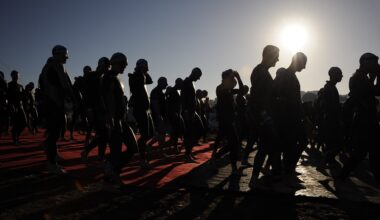The Importance of Flexibility and Mobility for Triathletes
Flexibility and mobility play a crucial role in the performance and recovery of triathletes. Engaging in triathlons requires a unique blend of strength, endurance, and efficiency across swimming, cycling, and running. However, many athletes overlook the importance of flexibility and mobility, which can significantly enhance their overall capabilities and decrease injury risks. Flexibility refers to the ability of the muscles and joints to move through a full range of motion, while mobility is the ability to transition easily between movements. A well-rounded training program includes mobility-focused workouts that target specific muscle groups. Enhancing flexibility can help triathletes maintain proper form while increasing joint mobility during each stage of the race. Furthermore, stretching regularly ensures that tight muscles do not limit performance, allowing for a more effective workout. Triathletes must commit to incorporating flexibility and mobility exercises into their routines, with focused sessions that could last between 15 to 30 minutes, several times weekly. This commitment may ultimately promote better results in competition. It is essential for triathletes, regardless of their experience level, to understand the long-term benefits of these practices.
Benefits of Increased Flexibility
Increased flexibility provides a myriad of benefits for triathletes, significantly impacting their performance. Many athletes experience enhanced athletic ability stemming from greater flexibility. This improvement contributes to better form and efficiency during training and races. When muscle and joint flexibility are optimized, athletes can achieve deeper stretches and fluid motions, which can capitalize on speed and power output. Additionally, flexibility decreases muscle tension, leading to improved recovery after strenuous workouts or events. By increasing blood flow to muscles, recovery time may be shortened, allowing athletes to train harder with less downtime. Achieving enhanced flexibility also reduces the risk of injuries, as tight muscles can lead to strains and sprains, negatively affecting an athlete’s training schedule. Proper flexibility training during the build-up to a race can prepare them for the rigors of intense competition, ensuring that they are primed and ready. Regularly incorporating flexibility into your training program can create a virtuous cycle, improving performance while reducing injury likelihood. Therefore, triathletes need to prioritize flexibility alongside their swim, bike, and run disciplines to ensure their well-rounded athletic development meets their competition aspirations.
Mobility Training Techniques
To achieve optimal mobility, triathletes can adopt various training techniques tailored to their specific needs. Dynamic stretching routines can be integrated into their warm-ups to facilitate joint movement. Examples include leg swings, arm circles, and torso twists to activate different muscle groups while enhancing mobility. Implementing foam rolling as part of a pre- or post-training regimen may help reduce muscle tightness and improve mobility by targeting fascia and deeper tissue layers. Additionally, incorporating yoga could prove beneficial, as it emphasizes stretching, strength, and balance, ensuring improved flexibility across all muscle groups. Mobility drills should specifically focus on skill development, targeting the hip, shoulder, and spine areas, all essential for triathletes. Effective mobility training encompasses various movements such as lunges, squats, and reach exercises designed to challenge stability and movement quality. Triathletes should also explore strengthening the core through mobility exercises, as a strong, stable core helps with overall posture. Developing a balanced routine that includes different mobility training techniques strengthens not just one aspect of athletic performance but dedicates attention to all muscles used throughout each triathlon leg, solidifying their athletic foundation.
Chains of muscle contribute to overall performance in triathlons, and mobility maximizes their potential. For example, during a swimming segment, enhanced shoulder mobility allows for a more pronounced reach, leading to improved stroke mechanics. Similarly, better hip mobility can help triathletes adopt a more powerful cycling position. Maintaining a proper cycling stance is vital for prolonged efficiency and reduced fatigue. Furthermore, a well-maintained range of motion in the legs promotes a more potent running stride, allowing for quicker transitions between bike and run segments. Triathletes must consider that sustaining mobility translates directly into effective race execution. Regular mobility assessments can help identify limitations and areas needing improvement. By working consistently to improve mobility, triathletes can develop their physical skills and their mental approach to competitions. Engaging in mobility work promotes a proactive mindset, fostering an atmosphere that encourages growth and learning through continuous adjustment. Moreover, a meticulous focus on improving mobility can contribute to boasting enhanced self-awareness, which can translate into increased confidence in competitive scenarios as athletes leverage their mobility skills for better performance. Each element builds upon the last, creating a cohesive experience.
Cultivating Joint Health
Maintaining joint health is essential for triathletes, and flexibility plays a central role in this process. Mobility training can prevent long-term joint deterioration commonly linked to repetitive stress injuries incurred during training and competition. Developing flexibility through targeted exercises promotes proper alignment and posture, which reduces joint wear and tear. Athletes should aim to develop a balanced musculature, applying consistent attention to all relevant muscle groups. This development prevents compensatory patterns that could lead to increased joint stress and debilitating injuries. Regular flexibility and mobility work also assists in lubricating joints, which is vital for maintaining optimal function. Enhancing synovial fluid production allows joints to move smoothly, enhancing operational efficiency throughout various triathlon segments. Moreover, promoting joint health can positively impact an athlete’s emotional state, as pain-free movement allows for more enjoyment during workouts and competitions. Incorporating movements such as glute bridges, hip openers, and ankle stretches can contribute greatly to overall joint health. Ultimately, maintaining joint health provides a robust foundation for effective training and recreational processes, enabling triathletes to persevere through challenges while continuously achieving personal bests.
Combining flexibility and mobility practices can lead to enhanced athletic longevity. Triathletes striving for long-term success must understand the significance of a comprehensive training plan, encompassing strength endurance, flexibility, mobility, and sport-specific conditioning. By fostering flexibility and mobility, athletes will reach their performance goals and improve their lifestyle and daily activities. A sustainable fitness regime promotes better everyday movements, enabling easier joint performance, which ultimately creates a more fruitful relationship with physical fitness over time. Every aspect works together harmoniously, ensuring athletes remain motivated to train and compete. Discovering the benefits of these practices can be enlightening, and overcoming initial resistance transforms one’s approach to training. Engaging in flexibility and mobility routines should not only feel beneficial physically but can also enhance mental well-being, providing a dual advantage. Moreover, an effective recovery regimen is intertwined with mobility and flexibility efforts, ensuring athletes adequately recharge before the demands of the next competition or workout. In this manner, flexibility and mobility should become integral components of a triathlete’s training philosophy and practice to maintain their competitive edge, achieve consistent progress, and reduce injury risk.
Integrating Flexibility and Mobility into Training
Successfully integrating flexibility and mobility-focused training into a triathlete’s existing schedule can yield a multitude of advantages. Taking the initiative to allocate time for these practices ensures a structured approach to overall athletic growth. Triathletes may consider scheduling specific days focused on flexibility training or integrating short mobility sessions throughout the week. Creative approaches to diversity could be explored, adding movements such as dance or martial arts that promote fluidity and range of motion. Staying adaptable fosters an inherent resilience that reflects positively on performance. Ensuring that flexibility and mobility sessions are enjoyable can prove beneficial, giving athletes a sense of accomplishment and discouraging disengagement from training. Enlisting the support of a coach or trainer specializing in flexibility and mobility enhancement can produce significant results, as they may tailor training regimens specifically to individual needs or weaknesses. Providing workshops or resources for athletes on these vital topics can further cultivate understanding and mastery of mobility and flexibility practices. By emphasizing continuous improvement, triathletes may cultivate an enduring competitive spirit that inspires confidence and ongoing commitment to their athletic journey.
To conclude, flexibility and mobility are intrinsic to triathletes’ overall performance and athletic journey. Ignoring these crucial aspects may lead to frequent injuries and stagnant progress both physically and mentally. Therefore, dedicating time to improving flexibility and mobility can support an athlete’s long-term success, forming a foundation for healthy training habits. Triathletes who engage in regular flexibility and mobility work report greater overall satisfaction with their training, often achieving more substantial results on competition day. Emphasizing mobility training creates a multi-dimensional advantage, ultimately leading to greater enjoyment across triathlon disciplines. Building a resilient body not only fosters strength and endurance but also promotes fluid motion and adaptability essential for transforming challenges into triumph. The ongoing pursuit of enhancing flexibility and mobility should be a continuous journey, where substantial growth and persistent learning form a part of the athletic experience. Committing to flexibility and mobility training trends may set the standard for what it means to be a dedicated, high-performing athlete. Triathletes should wholeheartedly embrace flexibility exercises, knowing they lay the groundwork for achieving greatness in the demanding world of triathlons. Ultimately, such commitment leads to lasting gains and fulfillment.


